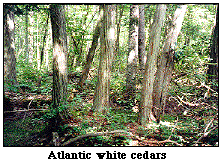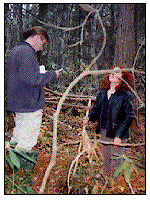 The students' characterization of the Atlantic white cedar
swamp vegetation revealed a number of interesting features. At the
outer part of the swamp giant rhododendrons, Atlantic white cedar and
highbush blueberry predominated, whereas in the interior of the
swamp, Atlantic white cedars were present almost exclusively. Their
canopy was so extensive here that it limited the amount of light
entering the swamp. Sphagnum moss covered the ground in both areas.
The students' characterization of the Atlantic white cedar
swamp vegetation revealed a number of interesting features. At the
outer part of the swamp giant rhododendrons, Atlantic white cedar and
highbush blueberry predominated, whereas in the interior of the
swamp, Atlantic white cedars were present almost exclusively. Their
canopy was so extensive here that it limited the amount of light
entering the swamp. Sphagnum moss covered the ground in both areas.
Since water tests established that the water found throughout the swamp contained little dissolved oxygen, it was concluded that only small amounts of water flow into the swamp.The sphagnum moss and the sediment beneath it had a "waterlogged" appearance, which was especially obvious near the swamp center. The swamp, which is "seasonally flooded", apparently derives most of its water from precipitation, and thus stagnant water prevails. Only one water outlet was observed at the swamp periphery.The outflow was slight, which was in keeping with the fall season.
The sediment cores revealed that there are large accumulations of "peat", or dark, partially decomposed organic matter within the swamp, suggesting that microbial decomposition was very slow. These findings coincided with the readings that oxidation was very limited beneath the surface of the swamp, and that peat depth increased as one nears the swamp center.
True "soils" are generally high in minerals, which are derived by erosion of rocky substrata, and then transported by water. Peat, on the other hand has little or no mineral content, in keeping with the lack of water flowing through the swamp. Certain minerals reduce acidity. This fact was brought out by the water testing results, which revealed that the swamp water had very low pH readings, i.e.,it was very acid, and that the pH readings were lower at the swamp center than at the periphery. Minerals also generally serve as nutrients for plant life. Few plants can adapt to low nutrient, highly acid conditions, but rhododendrons and sphagnum moss, as observed in student records, flourish in such circumstances. Curiously, Atlantic white cedars also have adapted to these stressful surroundings.
It was concluded that the dense swamp vegetation must furnish excellent habitats for wildlife - especially when animals are nesting, breeding, or over-wintering. Mammals such as mice, deer, and rabbits are known to feed on Atlantic white cedar twigs and bark.
There has been much speculation as to whether or not the construction of an industrial park on the Hackett Hill property would jeopardize the plant and animal species found in the forested wetlands.
Students were also asked whether or not their data indicated that critical aspects of the Atlantic white cedar wetland might be lost if industrial development occurred nearby the swamp. They concluded that altering the swamp's watershed would have severe efffects on its hydrological input of the swamp, and eventually result in its demise! Their reasons were as follows:
Adding pavement would result in increased water run-off, and due to the exposure of soil by development, this oxygen-containing water would carry numerous minerals into the swamp. Pollutants and nutrients derived from wastewater, fertilizers, etc. would also enter in this fashion. Thus the quality and quantity of water entering the swamps would be completely changed.
The addition of oxygen would encourage decomposition rates and lower the peat levels in the swamp, in accompanyment with the excessive flooding, and the acid nature of the water and sediment would be neutralized by minerals. It is very unlikely that the plant species presently found in the swamp, which are highly adapted to seasonal water level changes, and strongly acid, low oxygen, and low mineral conditions, would survive under such circumstances. The increased nutrient levels would then cause the "taking over" of the swamp by invasive, weedy, "opportunistic" species.
The wildlife habitats provided by the present swamp species would disapear. Moreover development would fragment the property into isolated dysfunctional units.
